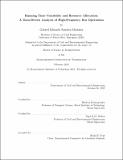Running time variability and resource allocation : a data-driven analysis of high-frequency bus operations
Author(s)
Sánchez-Martínez, Gabriel Eduardo
DownloadFull printable version (5.581Mb)
Alternative title
Data-driven analysis of high-frequency bus operations
Other Contributors
Massachusetts Institute of Technology. Department of Civil and Environmental Engineering.
Advisor
Harilaos Koutsopoulos and Nigel H.M. Wilson.
Terms of use
Metadata
Show full item recordAbstract
Running time variability is one of the most important factors determining service quality and operating cost of high-frequency bus transit. This research aims to improve performance analysis tools currently used in the bus transit industry, particularly for measuring running time variability and understanding its effect on resource allocation using automated data collection systems such as AVL. Running time variability comes from both systematic changes in ridership and traffic levels at different times of the day, which can be accounted for in service planning, and the inherent stochasticity of homogeneous periods, which must be dealt with through real-time operations control. An aggregation method is developed to measure the non-systematic variability of arbitrary time periods. Visual analysis tools are developed to illustrate running time variability by time of day at the direction and segment levels. The suite of analysis tools makes variability analysis more approachable, potentially leading to more frequent and consistent evaluations. A discrete event simulation framework is developed to evaluate hypothetical modifications to a route's fleet size using automatically collected data. A simple model based on this framework is built to demonstrate its use. Running times are modeled at the segment level, capturing correlation between adjacent segments. Explicit modeling of ridership, though supported by the framework, is not included. Validation suggests that running times are modeled accurately, but that further work in modeling terminal dispatching, dwell times, and real-time control is required to model headways robustly. A resource allocation optimization framework is developed to maximize service performance in a group of independent routes, given their headways and a total fleet size constraint. Using a simulation model to evaluate the performance of a route with varying fleet sizes, a greedy optimizer adjusts allocation toward optimality. Due to a number of simplifying assumptions, only minor deviations from the current resource allocation are considered. A potential application is aiding managers to fine-tune resource allocation to improve resource effectiveness.
Description
Thesis (S.M. in Transportation)--Massachusetts Institute of Technology, Dept. of Civil and Environmental Engineering, February 2013. "February 2012." Cataloged from PDF version of thesis. Includes bibliographical references (p. 129-132).
Date issued
2013Department
Massachusetts Institute of Technology. Department of Civil and Environmental EngineeringPublisher
Massachusetts Institute of Technology
Keywords
Civil and Environmental Engineering.